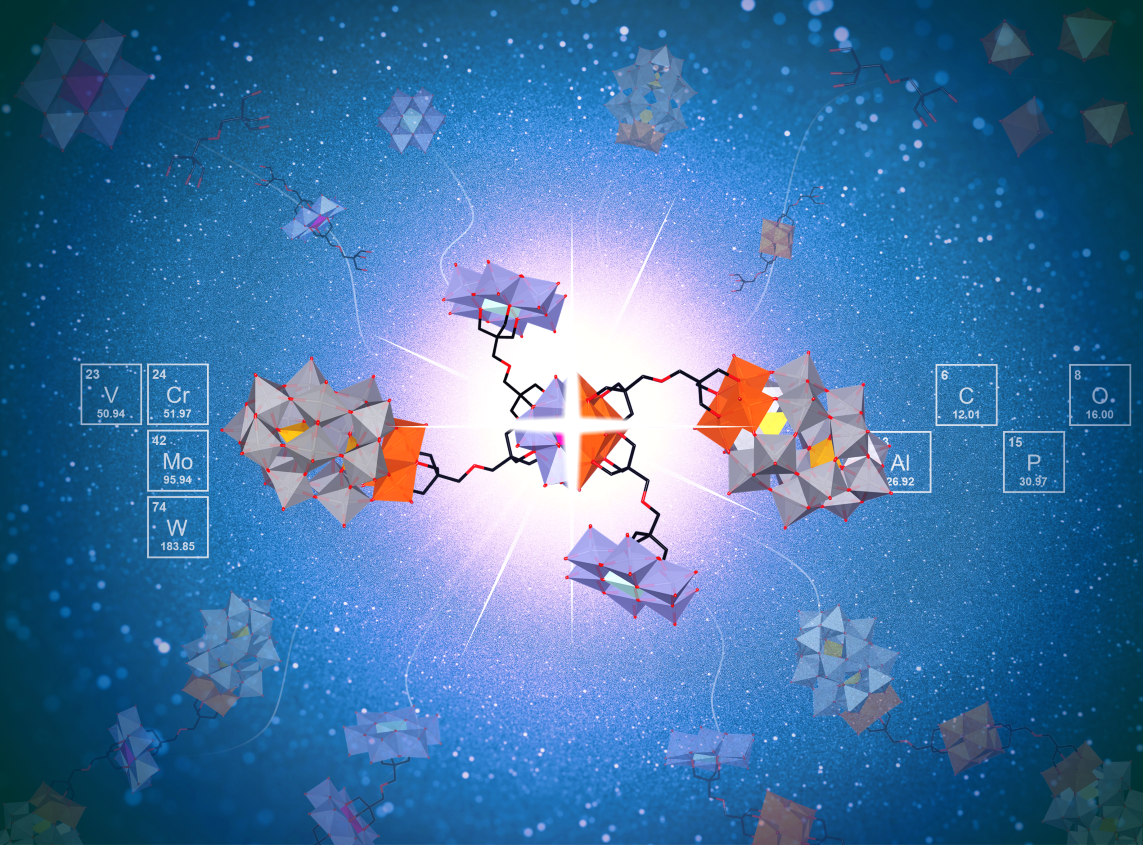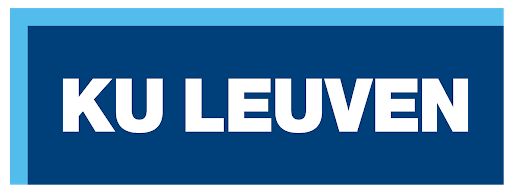POM Hybrid Structures

POMs can be combined with a wide variety of species to form (bio)organic-inorganic hybrids. We are developing synthetic strategies to create novel hybrid POM structures and to achieve their post-functionalization, which results in materials with interesting properties. Moreover, the formation of bio-inorganic and supramolecular assemblies by combining POMs with proteins and macromolecules is also being investigated. For example, Anderson-Evans polyoxometalate functionalized with biotin was used to induce the supramolecular assembly of proteins. These functional POM-based materials have many potential applications that are currently being explored by the group.
Some relevant references:
C-L. Liu*, M.A. Moussawi, G. Kalandia, D.E. Salazar Marcano, W.E. Shepard, and T. N. Parac-Vogt*
“Cavity-Directed Synthesis of Labile Polyoxometalates for Catalysis in Confined Spaces.”
Angew. Chem. Int. Ed., 2024, e202401940.
D.E. Salazar Marcano, S. Lentink, J.J. Chen, A. V. Anyushin, M. A. Moussawi, J. Bustos, B. Van Meerbeek, M. Nyman, and T. N. Parac-Vogt*
“Supramolecular Self-Assembly of Proteins Promoted by Hybrid Polyoxometalates.”
Small, 2024, 2312009.
D.E. Salazar Marcano, G. Kalandia, M. A. Moussawi, K. Van Hecke and T. N. Parac-Vogt*
“Rational Synthesis of Elusive Organic-Inorganic Hybrid Metal-oxo Clusters: Formation and Post-functionalization of Hexavanadates.”
Chem. Sci., 2023, 14, 5405-5414.
D. E. Salazar Marcano, M. A. Moussawi, A. V. Anyushin, S. Lentink, L. Van Meervelt, I. Ivanović-Burmazović and T. N. Parac-Vogt*
“Versatile Post-functionalisation Strategy for the Formation of Modular Organic-Inorganic Polyoxometalate Hybrids.”
Chem. Sci., 2022, 13, 2891-2899. (Cover Page)
Part of the themed collection: Most popular 2022 main group, inorganic and organometallic chemistry articles
Cluster-based Materials For Bio-inspired Applications

An in-depth understanding of the catalytic activity of polyoxometalates (POMs), towards biologically relevant reactions can be obtained by using a variety of substrates such as peptides, proteins, phosphoesters, and glucosides. POMs have been shown to exhibit remarkable reactivity towards amide, phosphoester and glycosidic bonds that are commonly found in nature. In particular, the ability of POMs to selectively interact with protein surfaces has been explored in our group to design them as novel catalysts for selective protein hydrolysis. So far we have developed a series of Zr, Hf, and Ce substituted POMs as artificial enzymes towards a variety of proteins differing in their size, structure, and charge. We also demonstrated that the catalytic activity of POMs can be “reversed” to switch from amide bond hydrolysis to amide bond formation. In addition to POMs, we recently demonstrated that other types of discrete MOCs can also act as efficient homogeneous or heterogenous catalysts for amide bond hydrolysis and formation.
Some relevant references:
S. A. M. Abdelhameed, F. de Azambuja, T. Vasović, N. D. Savić, T. Ćirković Veličković and T. N. Parac-Vogt*
“Regioselective protein oxidative cleavage enabled by enzyme-like recognition of an inorganic metal oxo cluster ligand.”
Nat. Commun., 2023, 14, 486.
Top Editors pick, highlighted in organic chemistry and chemical biology.
N. D. Savić, D. E. Salazar Marcano, S. Swinnen, A. Mullaliu, and T. N. Parac-Vogt*
“Self-Assembled Protein–Surfactant Nanoaggregates for Tunable Peptide Bond Hydrolysis by Polyoxometalate Nanoclusters.”
ACS Appl. Nano Mater., 2022, 5, 17159–17172.
F. de Azambuja, J. Lenie and T. N. Parac-Vogt*
“Homogeneous Metal Catalysts with Inorganic Ligands: Probing Ligand Effects in Lewis Acid Catalyzed Direct Amide Bond Formation.”
ACS Catal., 2021, 11, 271-277. (Cover Page).
J. Moons, F. De Azambuja, J. Mihailovic, K. Kozma, K. Smiljanic, M. Amiri, T. Cirkovic-Velickovic, M. Nyman and T. N. Parac-Vogt*
“Discrete Hf18 metal‐oxo cluster as a heterogeneous nanozyme for site specific proteolysis.”
Angew. Chem. Int. Ed., 2020, 132, 9179-9186.
MOF Bio-inspired Reactivity

We are developing 3D metal-organic frameworks (MOFs) and 2D metal-organic framework nanosheets (MONs) as a novel generation of nanozymes with proteolytic activity. These porous, hybrid organic-inoganic materials are composed of very robust {Zr6O8} metal-oxo clusters and are linked together by organic molecules. The metal clusters provide MOFs and MONs with strong Lewis acidity, ideal for the selective catalysis of peptide and protein hydrolysis under mild conditions. Due to the heterogenous character of MOFs and MONs, they can be easily separated from the reaction mixture to be recycled without significant loss of activity. We are currently pursuing studies that provide molecular insight into this novel reactivity of MOFs and are exploring the interplay between the MOF’s structure and its enzyme-like reactivity.
Some relevant references:
C. Simms, A. Mullaliu, F. de Azambuja,* G. Aquilanti and T. N. Parac-Vogt*
“Green, Safe, and Reliable Synthesis of Bimetallic MOF-808 Nanozymes With Enhanced Aqueous Stability and Reactivity for Biological Applications.”
Small, 2023, 2307236.
H. Ly, G. Fu, F. de Azambuja, D. De Vos and T. N. Parac-Vogt*
“Nanozymatic Activity of UiO-66 Metal-Organic Frameworks: Tuning the Nanopore Environment Enhances Hydrolytic Activity toward Peptide Bonds.”
ACS Appl. Nano Mater., 2020, 3, 8931-8938. (Cover Page)
A. Loosen, F. de Azambuja, S. Smolders, J. Moons, C. Simms, D. De Vos and T. N. Parac-Vogt*
“Interplay between structural parameters and reactivity of Zr6-based MOFs as artificial proteases.”
Chem. Sci., 2020, 11, 6662-6669. (Cover Page)
H. G. T. Ly, G. Fu, A. Kondinski, B. Bueken, D. De Vos, T. N. Parac-Vogt*
“Superactivity of MOF-808 toward Peptide Bond Hydrolysis”
J. Am. Chem. Soc. 2018, 6325-6335. (Cover page)
Contact Us
Prof. Dr. Tatjana N. Parac-Vogt
Department of Chemistry,
KU Leuven
ADDRESS
Celestijnenlaan 200F
3001 Leuven
Belgium
